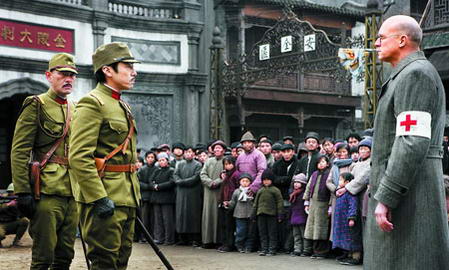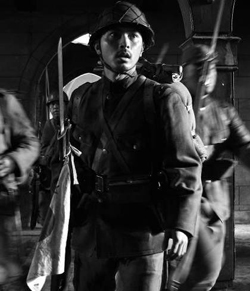City of sorrow: Competing film portrayals of the Nanjing Massacre
"There may be some, who knows, but from 58 volumes of historical documents released by Nanjing University I have studied, I never found a Japanese soldier with such a conscience. I just didn't find any examples in my reading."
While the "City of Life and Death" is a sober but breathtaking reflective documentary of brutality, the John Rabe biopic is more like a Hollywood production praising heroism and humanity in time of war.
 |
|
A scene from "John Rabe". [China.org.cn] |
"John Rabe" tells a good story and it has a good story to tell. Ulrich Tukur, whose appearance very much resembles the real John Rabe, gives a fine and convincing performance. The tone of the film is warm and full of hope. Apart from one scene in which people are beheaded, there is not much bloodshed and cruelty. The focus is on how much Rabe and his fellow foreigners changed when faced with a living hell, and how their humanity and courage came to the fore.
But the director approaches the story from the point of view of the foreign community in Nanjing, and some among the Chinese audience have suggested that such a perspective cannot really convey the pain suffered by ordinary Chinese people.
Some passages in the film are sluggish, and the role of a Chinese girl, played by actress Zhang Jingchu, is confusing and irrelevant. Huayi President Wang Zhonglei said the character of the girl was created by the director, Gallenberger.
"He wanted a symbolic figure to represent the Chinese people of that time – young, beautiful, brave, and full of hope," Wang said.
 |
|
In Lu Chuan's film, he gave us a perspective of a Japanese military officer who felt guilt and had a conscience that had not entirely faded away. But Professor Tang Daoluan said she just didn't find any examples in the 58 volumes of historical documents released by Nanjing University. [China.org.cn] |
"John Rabe" won four awards for best film, best actor, art direction and costume design at the annual German Film Prize ceremony held on April 24, and is expected to take 100 million yuan (US$14.65 million) in the Chinese market, its publicist said. Lu's "City of Life and Death" also paid its way, collecting over 65 million yuan (US$9.52 million) at box offices nationwide in its first week.
There seems little hope at the moment that the films will make it into the Japanese movie market. However, Chinese director Lu had created a modern classic and German director Gallenberger had delivered a new blockbuster.
Most importantly, they jointly provide us with three perspectives – from the points of view of the Chinese, the Japanese and the Nanjing expatriates – of one of the darkest episodes of the Second World War, and in this respect they recall Clint Eastwood's masterpieces, "Flags of Our Fathers" and "Letters from Iwo Jima".
 0
0 







Comments